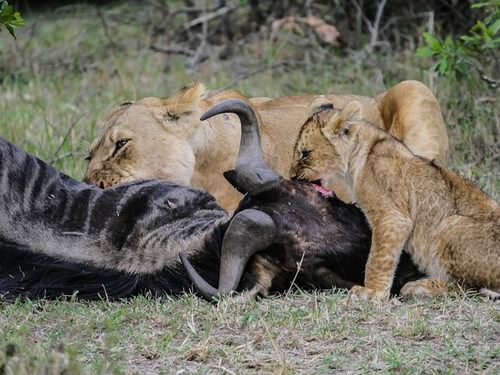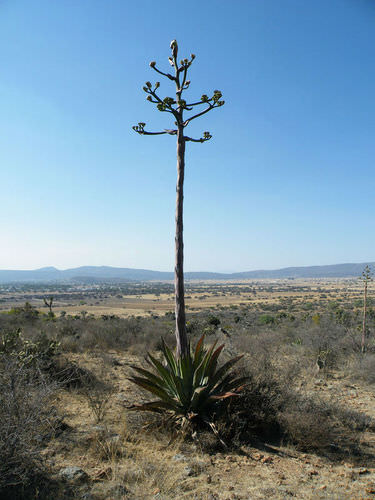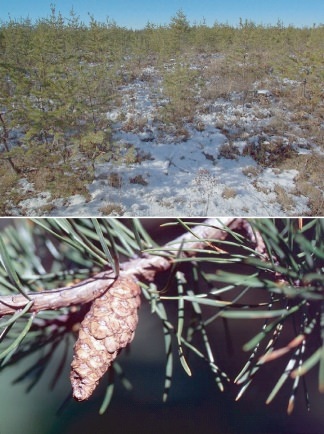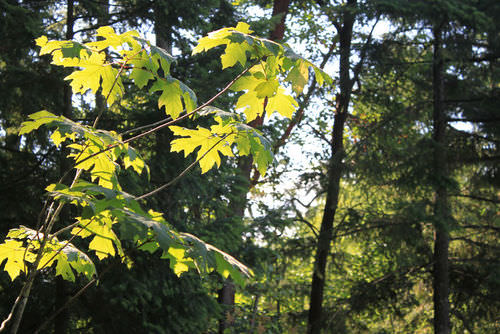18.32 人口增长限制 -- -- 高级
章节大纲
-
What causes to be limited?
::哪些原因受到限制?is definitely a limiting factor to population growth. Here, a lioness and her cub are devouring a wildebeest. But predation is not the only limiting factor. Some factors that limit population growth are abiotic, such as disease and weather .
::美食并不是唯一的限制因素。 限制人口增长的一些因素是非生物的,比如疾病和天气。Limits to Population Growth
::限制人口增长A limiting factor is a property of a population’s environment – living or nonliving – which controls the process of population growth. Biologists have identified two major types of limiting factors: Density-dependent factors and Density-independent factors.
::限制因素是控制人口增长过程的人口环境 — — 生活环境或非生活环境 — — 的属性。 生物学家已经确定了两大类限制因素:依赖密度因素和依赖密度因素。Density-Dependent Factors
::密度-依赖因数-
Density-dependent factors
promote
intraspecific competition
–
between members of the same
for the same resource – as the population grows and becomes more crowded.
Density-dependent limiting factors
have the potential to control
population size
. Consider
food
supply as an example. When
population density
is low, amount of food per individual is high, and birth rates are high. As density increases, food supply per individual decline and birth rates drop, causing growth rate to decline. Eventually, food shortages may lead to increased death rates and a negative growth rate, lowering population size. Lower population size means more food per individual, and the population begins to grow again, reaching or temporarily overshooting the
carrying capacity
. Food supply in this instance is a regulatory limiting factor, because it keeps the population at equilibrium. Density-dependent limiting factors may include:
::依赖密度因素促使特定群体内部竞争 — — 在同一资源方面,同一成员之间的竞争随着人口的增长和人口密集程度的提高而加剧。 依赖密度的限制性因素具有控制人口规模的潜力。 以粮食供应为例。 当人口密度低时,每人的粮食数量高,出生率高。 随着密度的增加,个人粮食供应下降和出生率下降,导致增长率下降。 最终,粮食短缺可能导致死亡率上升和负增长率,人口规模下降。 人口规模下降意味着每个个人有更多的食物,人口开始再次增长,达到或暂时超过承载能力。 本案中的粮食供应是一个监管性限制因素,因为它使人口保持平衡。 依赖密度的限制因素可能包括: -
Light
::照明灯 -
, nutrients/
minerals
, or oxygen
::、养分/矿物质或氧气 -
Waste, or the ability of an
to recycle
nutrients
and/or waste
::废物,或回收养分和/或废物的能力 -
Predation by
predators
which feed preferentially on more abundant
prey
::食肉动物食食食食食食食食食食食食食食食食食食食食食食食食食食食食 -
Disease and/or
parasites
::疾病和/或寄生虫 -
Space, with or without
territorial
behaviors, or nesting sites
::空间,有或无领土行为空间,或筑巢地点 -
Temperature
::温度 -
Aggressive behaviors, often combined with stress and effects on immune systems
::侵略行为,往往与压力和对免疫系统的影响相结合
Let’s look at two examples in detail, to emphasize the importance of density-dependent regulation of growth. First, waste products build up with increasing population density. Most environments have some capacity for recycling of wastes, but sometimes rapid population growth means that natural environmental systems can’t keep up. An interesting - if not completely natural - example is the growth of yeast populations through in the making of wine. Alcohol is a waste product for the yeast, even though it is the point of the process as far as we’re concerned. As the yeast population grows, alcohol builds up; but alcohol is toxic – to yeast as well as to humans – and after the concentration reaches 13%, increased death rates doom the yeast population. Therefore, no naturally fermented wine contains more than 13% alcohol.
::让我们详细研究两个例子,强调依赖密度的增长监管的重要性。 首先,废物产品随着人口密度的增加而积累。 大多数环境都有回收废物的一定能力,但有时人口快速增长意味着自然环境系统无法跟上。 一个有趣的 — — 如果不是完全自然的 — — 例子是酵母人口通过酿酒而增长。 酒精是酵母的废品,尽管就我们而言,酒精是这一过程的焦点。 随着酵母人口的增长,酒精增加;但酒精有毒 — — 对酵母和人类都是有毒的 — — 在浓度达到13 % 之后,死亡率的上升对酵母人口造成了影响。 因此,自然发酵母酒的酒精含量不会超过13 % 。-
A second density-dependent limiting factor is predation. Predators kill and eat their prey, of course, so predation increases prey death rate and can cause negative growth rates – population decline. If predators have multiple types of prey, and switch their feeding to specific prey only when they are abundant, predators may regulate prey population size. However, especially in northern climates, predators often specialize on a single prey
. Goshawks, for example, feed primarily on ruffed grouse, and Canada lynx depend on snowshoe hares (
Figure
). If predation causes a significant decline in the prey population, starving predators may experience their own (delayed) decrease in population as a result of lower birth rates or increased death rates. The result is a
predator-prey cycle
; both populations rise and fall, with predator populations trailing prey (
Figure
).
::第二个依赖密度的限制因素是食腐。 食肉动物杀死和吃食它们的猎物当然会增加猎物死亡率,从而导致负增长率 — — 人口下降。 如果食食肉动物有多种猎物,并且只有在捕食者富足时才会将食食转向特定的猎物,那么捕食者可能会控制猎物的规模。 然而,特别是在北部气候中,捕食者往往专门捕食单一猎物。 比如,鹰类动物主要吃吃被鞭打的野兽,而加拿大的林克斯则依赖雪花(Figure ) 。 如果食食肉动物导致猎食人口大幅下降,那么食食肉动物可能会由于出生率下降或死亡率上升而经历自身(延缓 ) 人口下降。 结果是一个食肉动物的周期;人口增加和下降,而食肉动物则随猎物(Figure ) 。
Populations of snowshoe hare (left) and their Canada lynx predator (right) show repeating cycles, with predator population changes trailing those of their prey. Repeating cycles of growth and decline characterize population dynamic interactions between some pairs of predator and prey species. Goshawks play the game with a little twist; when ruffed grouse populations in their Canadian conifer forest homes decline, they migrate southward. Grouse populations show ten-year cycles; note that the goshawk counts from Hawk Ridge in Duluth, Minnesota show ten-year “invasions” which correspond to prey population lows in Canada ( Figure ).
::戈斯霍克人玩这个游戏时稍有转折;当他们在加拿大小森林家园中受苦的农夫数量下降时,他们向南移徙。 格斯人显示十年周期;注意到明尼苏达州杜卢斯霍克山脊的戈斯霍克山数显示十年的“入侵 ” , 相当于加拿大的受猎人口低(图 ) 。The pattern of migration of goshawks observed at Hawk Ridge in Duluth, Minnesota, shows irruptions which correspond to low points in cycles of their Canadian prey populations (ruffed grouse). Such cycles are the result of density-dependent interactions between predator and prey. Predators cause increased death rates in prey populations, especially at high prey densities. When prey populations crash as a result of predation, predators are stressed and some (such as lynx) decline. Others, such as the goshawk, irrupt southward in search of higher-density populations. All of these factors have the potential to lower birth rates or increase death/ emigration rates via increased intraspecific competition at higher population densities. Many natural populations are kept at or below carrying capacity by one or a complex interaction among several of the above limiting factors.
::所有这些因素都有可能降低出生率或增加死亡率/移徙率,因为人口密度较高,具体内部的竞争加剧,许多自然人口因上述几个限制因素之间的一种或一种复杂的相互作用而处于或低于承受能力。Density-Independent Factors
::依赖密度因素-
Density-independent factors
can also limit populations, but they seldom regulate populations because they act irregularly, regardless of the population’s density. Populations limited by density-independent factors seldom reach carrying capacity. Weather is a good example. Agaves (Century Plants) reproduce once at the end of a long lifespan (
Figure
). The average lifespan is about 25 years rather than a full century, but an individual’s lifespan depends at least in part on erratic rainfall. Agaves will reproduce only after rainfall allows sufficient growth – however long that takes. Eventually, a wet season will bring about a single episode of flowering and the production of a huge number of
seeds
. Their growth and eventual
will, in turn, depend on erratic rainfall. The
density-independent factor
rainfall limits birth rate, which in turn limits growth rate, but because of its unpredictability, it cannot regulate Agave populations.
::依赖密度的因素也可能限制人口数量,但这些因素很少能够调节人口,因为不管人口密度如何,它们的行为不规则。 受依赖密度因素限制的人口很少达到承载能力。 天气就是一个很好的例子。 Agaves(Century Plants)在长寿结束时就繁殖了一次(图 ) 。 平均寿命约为25年,而不是整个世纪,但一个人的寿命至少部分取决于无规律的降雨量。 只有在降雨允许足够的增长 — — 不论时间有多长 — — 之后,Agaves才会繁殖。 最后,湿季将带来一连串花朵和大量种子的生产。 其增长和最终取决于无规律的降雨。 依赖密度因素降雨量限制了出生率,而这反过来限制了增长率,但由于其不可预测性,它无法调节阿加维的人口。
Each Century Plant reproduces only once during its long lifespan. This strategy allows it to gather sufficient water over a number of years in an environment where rainfall is scarce and unpredictable. Then, during an especially wet season, the plant produces a huge number of seeds and dies. Does the Century Plant’s pattern remind you of the salmon’s life cycle? Other density-independent limiting factors include human activities:
::其他依赖密度的限制因素包括人类活动:-
Pesticides and herbicides
: For example, DDT thinned the eggshells of Peregrine Falcons, reducing their birthrates and leading to their extirpation from the eastern half of North America.
::农药和除草剂:例如,滴滴涕稀释了 Peregrine Falcons的卵壳,降低了其出生率,并导致其在北美东半部的繁殖。 -
Habitat
destruction
: Conversion of prairies and grasslands worldwide drastically reduced populations of Burrowing Owls in North America and Giant Pandas in China.
::生境的破坏:全世界草原和草地的转化大大减少了北美的埋头猫和中国的巨型熊猫。
To conclude our discussion of population dynamics, let’s look at two sets of adaptations related to the logistic growth curve which describe the growth of most populations. These should remind you of the survival patterns we discussed earlier in this lesson. Recall that for logistic growth, r is the growth rate of the population, and K is the carrying capacity .
::在结束我们对人口动态的讨论时,让我们看看与描述大多数人口增长的物流增长曲线有关的两套适应方法。 这应该提醒大家我们在这个教训中早些时候讨论过的生存模式。 回顾物流增长是人口增长率,K是承载能力。r -Selected and K -Selected Species
::r 选定物种和K-选定物种Scientists have found that species adapted to unstable or unpredictable environments are usually limited by density-independent factors to population densities considerably lower than carrying capacity. Such environments favor adaptations which maximize growth rates: early maturity, small size, high numbers of small offspring, single episodes of reproduction, short life expectancy, and the ability to disperse widely. Because populations are usually far below carrying capacity, crowding is minimal, so these species invest little energy in competitive adaptations. Survivorship curves are Type III, with high early death rates. Such species are said to be "r-selected" – that is, selected for rapid growth. Weed species are often r -selected for colonization and rapid population of disturbed or newly created habitats such as roadsides, abandoned fields, mudslides, or lava flows. Jack pine trees are r -selected species which “pioneer” clear areas immediately after forest fires. They grow quickly in hot, dry soils and release seeds from cones which are opened only by fire – reproducing and dispersing seeds at just the right, if unpredictable, time ( Figure ).
::科学家们发现,适应不稳定或不可预测的环境的物种通常受到与人口密度不及承受能力相当低的人口密度依赖密度因素的限制。 这样的环境有利于适应最大限度的增长率:早成熟、小小小、小后代数量众多、单一繁殖期、预期寿命短、以及广泛分散的能力。 由于种群通常远低于承载能力,人群很少,因此这些物种在竞争性适应方面投入的能量很少。 幸存者曲线是第三类,死亡率很高。 据说这些物种是“由人为选择的” — — 即选择用于快速增长。杂草种往往被选择为殖民化的,以及快速的混乱或新创造的栖息地人口,如道路、废弃田地、泥石流或熔岩流。 Jack Pine树是被选取的物种,在森林火灾发生后立即“喷发”干净的地区。 它们迅速生长在热干燥的土壤中,释放出只有火才能打开的锥形的种子 — — 在不可预测的情况下,在正确的时间里再生并散布种子(Figurerere ) 。Jack pines show r-selected adaptations to an unpredictable (density-independent) limiting factor: fire. Cones (bottom image) open to release many tiny seeds only at high temperatures. The trees (top image) grow quickly in the open, bare areas left by forest fires, so are often called “pioneer” species. Whereas density-independent factors limit r-selected species in unpredictable environments, K-selected species are adapted to stable environments and regulated by density-dependent factors. Stable environments support K-selected populations at or near carrying capacity, at which point crowding leads to significant intraspecific competition. Such environments favor adaptations for efficient resource utilization which confer competitive ability. K-selected individuals often grow slowly to large size, live long, and delay but repeat reproduction of fewer offspring. They may provide extensive because they can count on environmental stability and survival of these relatively few offspring. Survivorship curves resemble the Type I pattern: long life expectancy and relatively low death rates in the stable environment. Maple trees are K-selected “climax” species which grow slowly in their own shade and reproduce relatively large seeds over a number of years throughout their relatively long lifespan ( Figure ).
::虽然依赖密度因素限制了在不可预测的环境中选择的物种,但K类选择的物种适应了稳定的环境,并受依赖密度因素的制约。稳定的环境支持K类选择的人口在载量或接近载量时,从而导致巨大的内部竞争。这种环境有利于适应高效率的资源利用,从而具有竞争能力。K类选择的人往往缓慢地长到大面积、长寿和延迟,但重复繁殖较少的后代。它们可能提供广泛,因为他们可以依赖环境稳定和这些相对较少的后代的生存。幸存者曲线类似于I类模式:长寿和稳定环境中的相对较低的死亡率。 红树是K类选择的“顶峰”物种,在自己的树荫下缓慢生长,并在相对长的生命周期(图示 ) 几年内繁殖相对较大的种子。Maple trees show K-selected adaptations to a predictable shade environment they help to create. Maples release relatively large seeds annually, and offspring grow slowly but steadily in the shaded, rich soil of their parents. Maples experience significant intraspecific competition, and their populations tend to be limited by density-dependent factors. Because maple forests tend to persist for long periods because they can grow in their own shade, they are often called “climax” species. Characteristics of r-selected and K-selected species are compared in Table .
::表中比较了r-选择物种和K-选择物种的特点。r -Selected Species K -Selected Species Environment Unstable Stable Type of Regulating Factors Density-independent Density-dependent Organism Size Small Large Maturity Early Late Number of Offspring Many Few Energy used to make each Individual Low High Average Life Expectancy Short Long Number of Reproductive Events per Individual Once Many times Survivorship Type III: only a few individuals live long lives
::类型三:只有少数人长寿Type I or II: most individuals live long lives In conclusion, all populations eventually reach limits, at or below carrying capacities for the ecosystems in which they live. Some have adaptations for rapid growth, but the unpredictable environments in which they live inflict high death rates. Others live in stable environments where death rates are relatively low, but their populations are high, so individuals must spend energy on costly competitive strategies in order to gather scarce sunlight, nutrients, or water - or fight disease or predation. Many species live between these extremes, but all populations have limits.
::最后,所有人口最终都会达到极限,达到或低于其生活生态系统的承载能力,有些人有适应快速增长的适应能力,但是他们生活的不可预测的环境造成高死亡率,其他人生活在死亡率相对较低的稳定环境中,但人口却很高,因此,个人必须花精力在代价高昂的竞争战略上,以便收集稀少的阳光、养分或水,或防治疾病或掠夺。许多物种生活在这些极端之间,但所有人口都有限度。Summary
::摘要-
Density-dependent limiting factors lower birth rates or increase death/emigration rates via increased intraspecific competition at higher population densities.
::依赖密度的限制性因素降低出生率或增加死亡率/移徙率,其原因是人口密度提高导致特定内部竞争加剧。 -
Many natural populations are kept at or below carrying capacity by one or a complex interaction among several density-dependent limiting factors, such as competition, predation, or disease.
::许多自然人口在承受能力上或低于承受能力时,由于竞争、掠夺或疾病等若干依赖密度的限制因素之间的一种或一种复杂的相互作用。 -
Density-independent factors, such as rainfall, drought, or pollution, can also limit populations, but they seldom regulate populations because they act irregularly, regardless of the population’s density.
::依赖密度的因素,如降雨、干旱或污染等,也可能限制人口,但它们很少管制人口,因为不论其人口密度如何,它们的行为都是不正常的。 -
Cycles of growth and decline limit some predator and prey populations.
::增长和下降的周期限制了一些掠食者和猎食者。 -
Density-independent factors limit r-selected species in unpredictable environments, while K-selected species are adapted to stable environments and regulated by density-dependent factors.
::依赖密度因素限制在不可预测的环境中选择r物种,而K类选择物种则适应稳定环境,并受依赖密度因素的制约。
Review
::回顾-
Compare and contrast density-dependent and density-independent limiting factors.
::比较和对比依赖密度和依赖密度的限制因素。 -
Relate predator-prey cycles to density-dependent population control.
::将食肉动物-食肉动物周期与依赖密度的人口控制相对应。 -
Compare and contrast the adaptations and environmental characteristics typical of r-selected species to those of K-selected species.
::将r类选定物种的适应和环境特点与K类选定物种的适应和环境特点进行比较和比较。
-
Density-dependent factors
promote
intraspecific competition
–
between members of the same
for the same resource – as the population grows and becomes more crowded.
Density-dependent limiting factors
have the potential to control
population size
. Consider
food
supply as an example. When
population density
is low, amount of food per individual is high, and birth rates are high. As density increases, food supply per individual decline and birth rates drop, causing growth rate to decline. Eventually, food shortages may lead to increased death rates and a negative growth rate, lowering population size. Lower population size means more food per individual, and the population begins to grow again, reaching or temporarily overshooting the
carrying capacity
. Food supply in this instance is a regulatory limiting factor, because it keeps the population at equilibrium. Density-dependent limiting factors may include:






